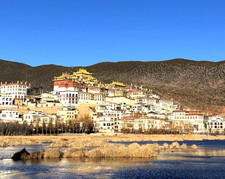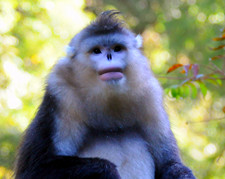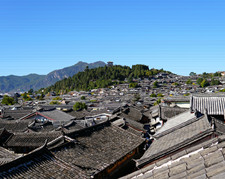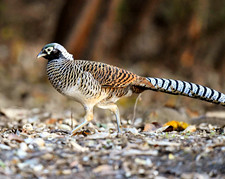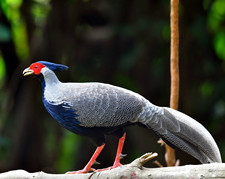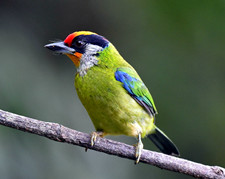Trip Details
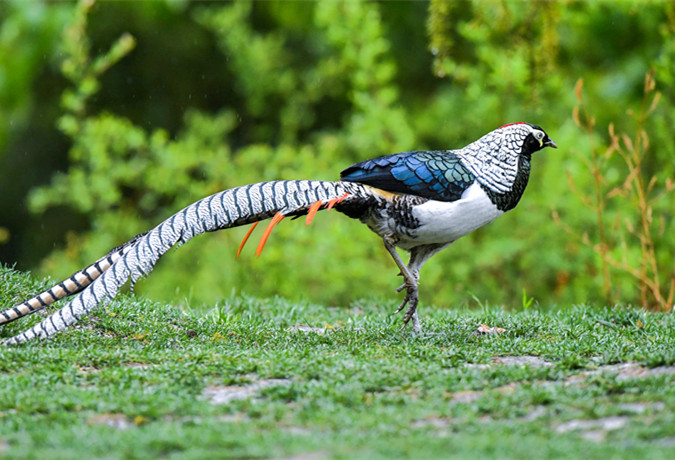
12 Days Photograph the Wild Side of Yunnan
Date: Dec. 18 to Dec. 29, 2025, 2026
Price: From 3460USD/PAX
Trip Focus: Photo + Birds
Status: Open to Booking
Route: Shangri-La City—Black Snub-nosed Monkey Nature Reserve—Lijiang-Heqing-Dali-Cangshan-Baihualing-Gaoligongshan Natural Park-Yingjiang-Tengchong
Trip Code: PH006
Overview
Yunnan, which is often referred as "the place south of the colorful clouds", is the most diverse province in China due to its numerous ethnic minority groups and the variety of landscapes. Famed as the "Kingdom of Plants and Animals", Yunnan may have the largest number of birds and mammal species that are restricted to different types of habitats. This trip is specially designed for photographers who have a wild range of photography targets and travelers who hope to see both nature and culture in one trip. We start our journey from Shangri-la City and travel through some of the best spots for biodiversity. This will give us ample opportunity to get some first-class nature and culture images.
On this trip, we will try our best to show you the wild side of Yunnan and you can record it by your lens. You will be marveled by the incredible Black Snub-nosed Monkey. Besides, we have chances to take photos of a great diversity of pheasants, laughingthrushes, babblers, parrotbills, and hornbills, as Yunnan has recorded over 940 bird species including around 40 endemic species, ranking first in China in terms of the total. To ensure the best quality of the trip, we will arrange our top guide who normally guides birding trips in Yunnan for our birding-focused department in our company. Welcome to join us for photographing some extraordinary birds like White-cheeked Partridge, Rufous-throated Partridge, Red Junglefowl, Kalij Pheasant, Silver Pheasant, Mrs. Hume's Pheasant, Lady Amherst's Pheasant, Grey Peacock Pheasant, Grey-headed Swamphen, Great Hornbill, Oriental Pied Hornbill, Golden-throated Barbet, Blue-throated Barbet, Long-tailed Broadbill, etc. Our guide not only speaks good English, but also have good knowledge of birds, photography, and ethnic culture. Give us a chance, we will make one of your top trips in your life.
Highlights:
• Photograph in the most popular bird and wildlife sites of Yunnan in winter which is the best season that birds move to lower altitudes and tend to stay as flocks.
• Good chance for mammals like Black Snub-nosed Monkey, Skywalker Hoolock Gibbon, Phayre's Leaf-monkey, Stump-tailed Macaque, etc. And the nice chance for birds like Black-necked Crane, Black Stork, Bar-headed Goose, White-tailed Eagle, Steppe Eagle, etc.
• Record a great diversity of ethnic cultures in Yunnan with your cameras, such as the culture of Han Chinese, Hui people, Kham Tibetans in Shangri-La City, and Naxi ethnic minority in Lijiang.
• Guided by an accomplished photograph guide who is specialized in birds, wildlife, and culture photography, with plenty of patience and enthusiasm to answer your questions and provide technical supports.
• Travel in a small group with 12 people at maximum to ensure the quality of your trip and each travel get enough attention for individual assistance.
Introduction to Trip Destinations:
Songzanlin Monastery
Songzanlin Monastery, also known as Ganden Sumtseling Monastery, as well as "Little Potala" according to its appearance, is the largest Tibetan Buddhist monastery in Yunnan province which is located at the foot of Foping Mountain near Shangri-La City with the altitude about 3,300m. In 1679, Dalai Lama chose this place by divination and it has been reconstructed several times. You will love its architecture that combined with both Tibetan and Han Chinese.
Also, it is a good excuse to visit the monastery for the treasure collections accumulated from each dynasty.
Black Snub-nosed Monkey Nature Reserve
Black Snub-nosed Monkey lives in high-elevation evergreen conifer forests and mixed conifer and oak forests from 3,400m to 4,100m above sea level. It is endemic to China. There are only about 3,000 left according to the data of 2013, and most of the black snub-nosed monkeys live in Yunnan. When you pay a visit to the Black Snub-nosed Monkey Nature Reserve, you will fall in love with this large monkey with a very long tail. You will be attracted by its bare facial skin which is pink with a black patch on the bluish nose.
What is more, its lip is deep reddish-pink. What a beautiful lip color.
Lijiang Ancient Town
Lijiang Ancient Town of Yunnan was listed as UNESCO World Heritage Site since 1997. It is one of the four best-preserved ancient towns in China, along with Langzhong Ancient Town in Sichuan province, Pingyao Ancient Town in Shanxi province, and Shexian Ancient Town in Anhui province. As a well-preserved ancient town, Lijiang is also known by its ethnic minorities with brilliant culture such as the Naxi ethnic minority. That is why the buildings here incorporate the best parts of the architectural traits of Han, Bai, and Tibetan into a unique Naxi style. Also, in Lijiang, you will find its romantic and relaxing charm of the town without city walls.
Cangshan National Geopark
Cangshan National Geopark is located in western Yunnan at the southern end of the Qinghai-Tibet Plateau. Since the magnificent Himalayas end at Cangshan Mountain, it is known as the "Eave of the Roof of the World". It is great to visit Cangshan Mountain in the park for a bird view of Dali Ancient Town and Erhai Lake. Cangshan Mountain is a sacred mountain that combines with beautiful natural scenery and historical sites. What's more, it is home to 61 species of aquatic plants and 51 species of water birds. Local people like to visit here for its snow-capped peaks, flowing clouds, murmuring brooks, which becomes one of the four best highlights of Dali.
Baihualing (Gaoligong Moutains)
Located on the western side of Yunnan province, Baihualing (Gaoligong Mountains) belongs to the south end of the Hengduan Mountains, the elevation changes sharply from around 210 meters above sea level at the bottom to 5,128 meters above sea level at the highest peak. As a result of its 7 complete vegetation types, Gaoligong is rated as one of the 36 hot spots for biodiversity by Conservation International. So far around 525 bird species have been recorded here, accounting for 43.3% of the total in Yunnan province, in which 40 are bird species under national protection.
Gaoligongshan Natural Park
Gaoligongshan Natural Park has the best chance to find a unique creature, the Skywalker Hoolock Gibbon (Gaoligong Hoolock Gibbon). It is one of three species of hoolock gibbons and was first described in January 2017. The Skywalker Hoolock Gibbon is named after Luke Skywalker from the Star Wars franchise, as the scientists who described it are fans of the franchise. With some luck, we can also expect Phayre's Leaf-monkey, Stump-tailed Macaque, Bengal Slow Loris, Black Giant Squirrel, etc. It is also a good spot for some bird species such as Silver Pheasant, Black Eagle, Crested Goshawk, Great Barbet, Golden-throated Barbet, Blue-throated Barbet, etc.
Tengchong Volcanic Geothermal National Geological Park
The Tengchong Volcanic Geothermal National Geological Park is located in the western parts of the Gaofenggong Mountains in the Hengduan Mountain Range which is only 40km away from the border with Myanmar or Burma. It is a well-known young volcanic and geothermal area in China and is famed as the field with the highest temperature. There are about 70 volcanoes and the volcanic cluster here is world-famous for its complete examples, large scale, intensive distribution, and complete preservation. The park is regarded as a "natural volcanic geology museum" and the roads leading to the park are paved with volcanic rock which is a good solution for drainage.
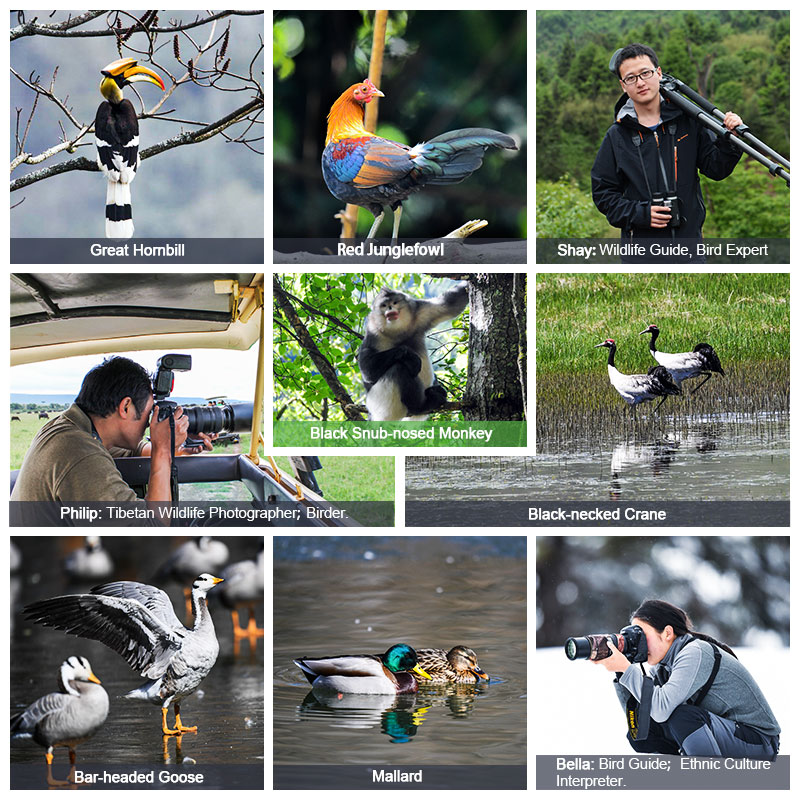
What Makes AbsolutePanda Excellent?
We use AbsolutePanda as company brand because of our deep love toward panda and our determination to create your absolutely enjoyable panda trips.
Map
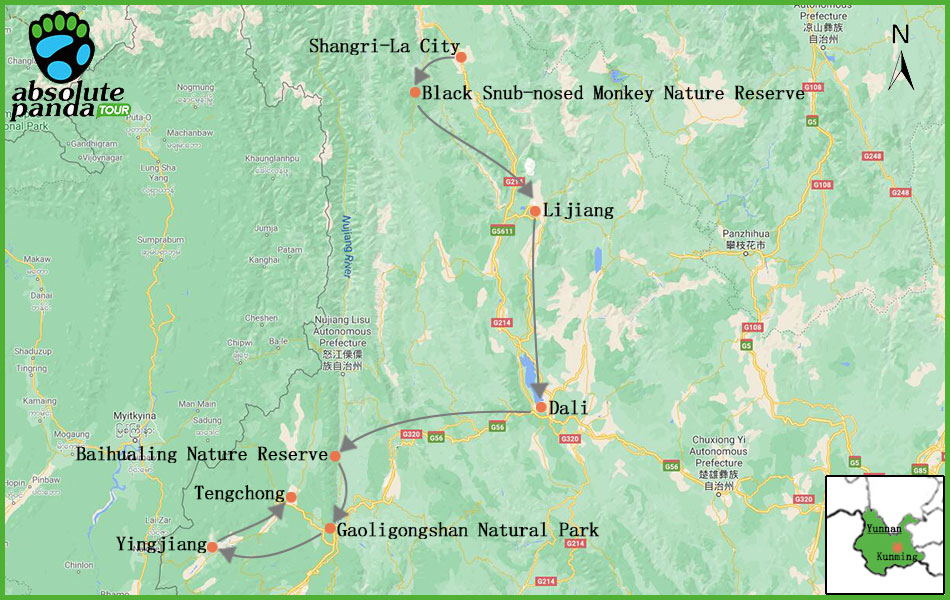
Photograph the Wild Side of Yunnan Trip Map
Itinerary
Outline:
Day 1. Arrive in Shangri-La City. (D)
The airport pick-up. Overnight: Shangri-La City (3,300m)
Day 2. Shangri-La City—Black Snub-nosed Monkey Nature Reserve. 150km 3.5h (BLD)
Drive to Black Snub-nosed Monkey Nature Reserve after visiting Napahai Lake and Songzanlin Monastery. Overnight: Black Snub-nosed Monkey Nature Reserve (2,800m)
Day 3. Black Snub-nosed Monkey Nature Reserve—Lijiang. 180km 4h (BLD)
Drive to Lijiang Ancient Town in the afternoon. Overnight: Lijiang (2,400m)
Day 4. Lijiang-Heqing-Dali. 240km 4h (BLD)
Drive to Dali via Heqing. Overnight: Dali (2,000m)
Day 5. Dali-Cangshan-Baihualing. 320km 5.5h (BLD)
Drive to Baihualing after visiting Cangshan National Geopark. Overnight: Baihualing (1,400m)
Day 6. Baihualing. (BLD)
Explore in Baihualing (Gaoligong Mountains) and photograph birds. Overnight: Baihualing (1,400m)
Day 7. Baihualing-Gaoligongshan Natural Park. 100km 2h (BLD)
Drive to Gaoligongshan Natural Park in the afternoon. Overnight: Nankang (1,500m)
Day 8-9. Gaoligongshan Natural Park. (BLD)
Explore the Skywalker Hoolock Gibbon in Gaoligongshan Natural Park. Overnight: Nankang (1,500m)
Day 10. Gaoligongshan Natural Park-Yingjiang. 300km 5h (BLD)
Drive to Yingjiang via Hongbenghe (Xiniao Valley) to photograph birds. Overnight: Yingjiang (860m)
Day 11. Yingjiang-Tengchong. 80km 1.5h (BLD)
Drive to Tengchong in the afternoon. Overnight: Tengchong (1,700m)
Day 12. Tengchong depart. (B)
The airport see-off.
Details:
Day 1. Arrive in Shangri-La City. Meals: D
Arrive at the airport, meet our AbsolutePanda guide and transfer to your hotel. We will explore the city if time permits. At the welcome dinner, we will have the first taste of Yunnan cuisine.
Overnight: Shangri-La City (3,300m)
Day 2. Shangri-La City—Black Snub-nosed Monkey Nature Reserve. 150km 3.5h Meals: BLD
We will drive to Napahai Lake and photograph birds in the morning. Napahai Lake is a seasonal alpine lake surrounded by mountains. In winter, parts of the lake turn into small grasslands and wetlands with the evaporation of the water. That's why each year thousands of waterfowls and grassland birds visit the area during the wintertime such as Black-necked Crane, Black Stork, Bar-headed Goose, Greylag Goose, Ruddy Shelduck, Great White Egret, Chinese Pond Heron, Himalayan Griffon, etc. Then, we will pay a visit to Songzanlin Monastery, also known as "Little Potala" according to its appearance. It is the largest Tibetan Buddhist monastery in Yunnan province. Photograph its architecture that combined with both Tibetan and Han Chinese. In the afternoon, we will drive to Black Snub-nosed Monkey Nature Reserve.
Overnight: Black Snub-nosed Monkey Nature Reserve (2,800m)
Day 3. Black Snub-nosed Monkey Nature Reserve—Lijiang. 180km 4h Meals: BLD
We will search for black snub-nosed monkeys in the morning. The monkey, also known as Yunnan Snub-nosed Monkey, is a large black and white primate that lives only in the southern Chinese province of Yunnan. This area is also home to some interesting bird species including Stripe-throated Yuhina, Bar-winged Wren Babbler, Giant Laughingthrush, Elliot's Laughingthrush, Black-faced Laughingthrush, Long-tailed Rosefinch, and so on. Then, we will drive to Lijiang Ancient Town in the afternoon. Lijiang Ancient Town was listed as UNESCO World Heritage Site since 1997. It is one of the four best-preserved ancient cities in China, along with Langzhong Ancient Town in Sichuan, Pingyao Ancient City in Shanxi, and Shexian Ancient Town in Anhui. Here you can also see another group of the ethnic minority in China called the Naxi ethnic group.
Overnight: Lijiang (2,400m)
Day 4. Lijiang-Heqing-Dali. 240km 4h Meals: BLD
In the morning, we will drive to Heqing. Heqing is a place with beautiful scenery, rich products, and simple folk customs. It is a shining pearl dotted between Dali and Lijiang. There are abundant underground water and numerous springs in Heqing which make it a good spot to photograph birds such as Common Moorhen, Little Grebe, Grey Goose, Mallard, and so on. Then we will drive to Dali Ancient Town. Dali Ancient Town, first built in Ming Dynasty, is most famous for the Erhai Lake and the grand Cangshan Mountain that standing by the western side of the lake. Also, it is a good place to have a bite of the Bai ethnic minority group's traditions and culture. If time permits, we will go to Erhai Lake to photograph some water birds like Purple Swamphen (Grey-headed Swamphen).
Overnight: Dali (2,000m)
Day 5. Dali-Cangshan-Baihualing. 320km 5.5h (BLD)
In the morning, we will pay a visit to Cangshan National Geopark. It is great to visit Cangshan Mountain in the park for a bird view of Dali Ancient Town and Erhai Lake. Cangshan Mountain is attractive for its rich forest species of low and middle elevation. According to statistics, over 200 bird species have been recorded here due to the various habitat types. We drive along a paved mountain road up to the higher part of the mountain and start our morning search for the star bird Lady Amherst's Pheasant. Then we slowly walk down on the winding road to search for other specials including Spotted Nutcracker, Black-browed Tit, Yunnan Fulvetta, Stripe-throated Yuhina, Rufous-capped Babbler, Elliot's Laughingthrush, etc. In the afternoon, we will head to Baihualing.
Overnight: Baihualing (1,400m)
Day 6. Baihualing (Gaoligong Mountains). (BLD)
Explore in Baihualing to photograph birds. Located on the western side of Yunnan, Baihualing (Gaoligong Mountains) belongs to the south end of the Hengduan Mountains, the elevation changes sharply from 210 meters to 5,128 meters. With its 7 complete vegetation types, Gaoligong is rated as one of the 36 hot spots for biodiversity by Conservation International. So far around 525 bird species have been recorded here, accounting for 43.3% of the total in Yunnan province, in which 40 are bird species under national protection. Winter is the best birding time in this area, as most birds move to lower altitudes where is warmer and has more food resources available. Besides, the birds tend to stay as flocks in winter which gives us more opportunities to photograph them.
Overnight: Baihualing (1,400m)
Day 7. Baihualing-Gaoligongshan Natural Park. 100km 2h (BLD)
We will have another morning time to photograph birds in Baihualing. There are a lot of "bird blinds" built in Baihualing because of the development of the bird watching and bird photography which should give us more opportunities to record the birds such as the Silver Pheasant, Mrs. Hume's Pheasant, Hill Partridge, Mountain Bamboo Partridge, Rufous-throated Partridge, Slender-billed Scimitar Babbler, Red-tailed Laughingthrush, Chestnut-crowned Laughingthrush, Blue-winged Laughingthrush, Scarlet-faced Liocichla, Grey-winged Blackbird, Long-tailed Thrush, Wedge-billed Wren Babbler, Grey-bellied Tesia, Slaty-bellied Tesia, Chestnut-headed Tesia, etc. Then we will drive to Gaoligongshan Natural Park in the afternoon.
Overnight: Nankang (1,500m)
Day 8-9. Gaoligongshan Natural Park. (BLD)
We will spend two days exploring the Skywalker Hoolock Gibbon in Gaoligongshan Natural Park. In Gaoligongshan Natural Park, we will have the best chance to find the unique creature which is one of the three species of hoolock gibbons. The Skywalker Hoolock Gibbon is named after Luke Skywalker from the Star Wars franchise, as the scientists who described it are fans of the franchise. With some luck, we can also expect Phayre's Leaf-monkey, Stump-tailed Macaque, Bengal Slow Loris, Black Giant Squirrel, etc.
Overnight: Nankang (1,500m)
Day 10. Gaoligongshan Natural Park-Yingjiang. 300km 5h (BLD)
We will continue our exploration of Gaoligongshan Natural Park in the morning.
Birding is also exciting here, we will have the chance to encounter some sought-after species including Silver Pheasant, Black Eagle, Crested Goshawk, Great Barbet, Golden-throated Barbet, Blue-throated Barbet, Crimson-breasted Woodpecker, Bay Woodpecker, Black-eared Shrike Babbler, Black-winged Cuckooshrike, Yellow-cheeked Tit and so on. Then, if time permits, we will drive to Hongbenghe (Xiniao Valley) for more chance of bird photography.
Overnight: Yingjiang (860m)
Day 11. Yingjiang-Tengchong. 80km 1.5h (BLD)
In the morning, we will photograph the birds around Yingjiang. Located at the end of the southwest, Yingjiang is a county that borders with Myanmar. With opulent sunshine, flourishing virgin forests, and various habitats, over 680 kinds of birds have been recorded here, which count around 50% of birds of China. That's what makes Yingjiang one of the unmissable birding destinations in China. Then, we will drive to Tengchong.
Overnight: Tengchong (1,700m)
Day 12. Tengchong depart. Meals: B
The airport drop-off. On the final day of this tour, our team will escort you to the airport and assist you with luggage check-in.
Notes:
1. If you need help in arranging a flight to Shangri-La City from other major cities of China such as Beijing, Shanghai, Xian, Chengdu, or a departure flight from Tengchong, please feel free to contact us, we are more than happy to provide any support we can to facilitate your trip planning.
2. The overnight altitudes and driving hours listed in the itinerary are just for your rough reference.
Dates & Prices
Accommodations
FAQs
1. What kind of food will be provided?
One of the principles of AbsolutePanda toward food during travel is that we take every meal as an important part of the travel experience. So we carefully choose restaurants. Whenever it is possible we always dine at a nice local popular restaurant. In this way, our travelers enjoy the authentic local gourmet and try as many different varieties as possible. For western travelers, we also prepare some simple western breakfast though you are always welcome to try local Chinese style.
2. What kind of lodging will we stay at?
We will choose featured local guest houses, three or four-star hotels run by local people. It is a great chance to experience local hospitality and culture by staying with lovely people.
3. If I have dietary restrictions, will that be a problem for your team to accommodate?
Our team is experienced at making sure all of our client's needs are met. If you or anyone in your group has specific requirements for food, we are happy to accommodate your needs.
4. Does your team have tripods and binoculars that guests can use during the tour?
Yes, our company has prepared different sets of equipment for the conveniences of our clients, such as cameras, lens, tripods, binoculars, spotting scope and walking sticks, etc. Feel free to contact us ahead of the time if you need any assistance from us.
5. Is it acceptable to photograph people on this tour?
The different ethical culture we will unveil to you on this tour gives you lots of unique chances to take some breathtaking photos that showcase the unique and vibrant communities in southwest China. In times of taking photos of people, we do suggest you ask first before photographing. If you are not quite sure, please ask our guide for help.
6. What kind of mammals do we expect to see on this trip?
Black Snub-nosed Monkey, Skywalker Hoolock Gibbon, Phayre's Leaf-monkey, Stump-tailed Macaque, Bengal Slow Loris, Black Giant Squirrel, etc. Sure, for wildlife watching, the only thing we can do is try our best to search for them at the right time and the right place. The rest part should be a matter of luck.
7. What bird species do we expect to see on this trip?
Black-necked Crane, Black Stork, Bar-headed Goose, White-tailed Eagle, Steppe Eagle, Imperial Eagle, Great Hornbill, Oriental Pied Hornbill, Wreathed Hornbill, Grey Peacock Pheasant, Red Junglefowl, Kalij Pheasant, White-cheeked Partridge, Lady Amherst's Pheasant, Silver Pheasant, Mrs. Hume's Pheasant, Hill Partridge, Mountain Bamboo Partridge, Rufous-throated Partridge, Slender-billed Scimitar Babbler, Red-billed Scimitar Babbler, Coral-billed Scimitar Babbler, Red-tailed Laughingthrush, Chestnut-crowned Laughingthrush, Blue-winged Laughingthrush, Scarlet-faced Liocichla, Alexandrine Parakeet, Red-breasted Parakeet, Blossom-headed Parakeet, Golden-throated Barbet, Blue-throated Barbet, Broad-billed Warbler, Crested Treeswift, Bay Woodpecker, Greater Yellownape, Stripe-breasted Woodpecker, White-browed Piculet, Long-tailed Broadbill, Silver-breasted Broadbill, Red-tailed Minla, Scarlet Finch, Grey-headed Parrotbill, Spot-breasted Parrotbill, Rufous-headed Parrotbill, Pale-billed Parrotbill, Whiskered Yuhina, Rufous-vented Yuhina, Beautiful Sibia, Long-tailed Sibia, Large Niltava, Rufous-bellied Niltava, Golden Bush Robin, Rusty-fronted Barwing, Yellow-cheeked Tit, Fire-tailed Sunbird, Black-throated Sunbird, Mrs. Gould's Sunbird, Green-tailed Sunbird, Dark-sided Thrush, Grey-winged Blackbird, Long-tailed Thrush, Wedge-billed Wren Babbler, Streaked Wren Babbler, Grey-bellied Tesia, Slaty-bellied Tesia, Chestnut-headed Tesia, Yunnan Nuthatch, Giant Nuthatch, Velvet-fronted Nuthatch, White-browed Fulvetta, Rusty-capped Fulvetta, Yunnan Fulvetta, Pink-rumped Rosefinch, Sharpe's Rosefinch, Long-tailed Rosefinch, Chinese White-browed Rosefinch, etc. Sure, for bird watching, the only thing we can do is try our best to search for them at the right time and the right place. The rest part should be a matter of luck.
Email us if you have any questions. Read our FAQ
Testimonials
Videos & Photos
Welcome to email us and share your trip video with us. Video Album of AbsolutePanda
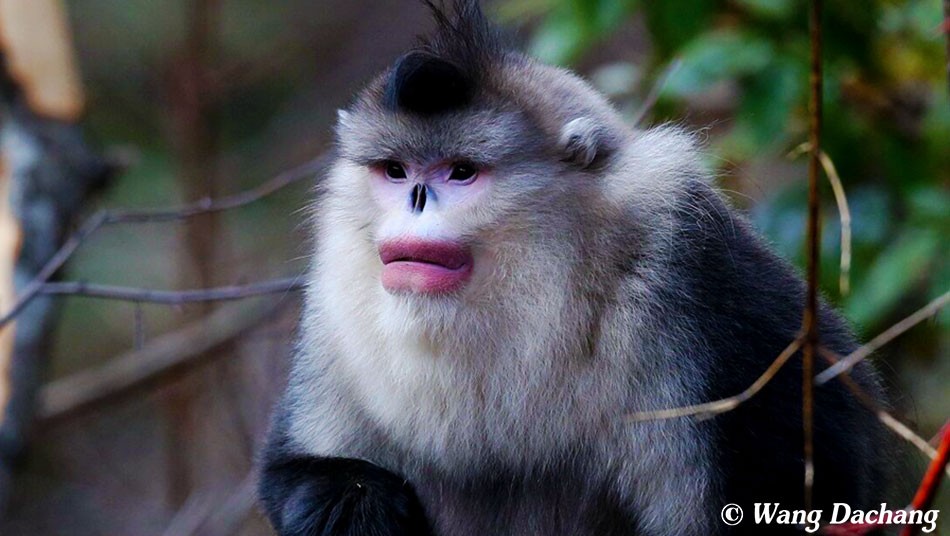
Black Snub-nosed Monkey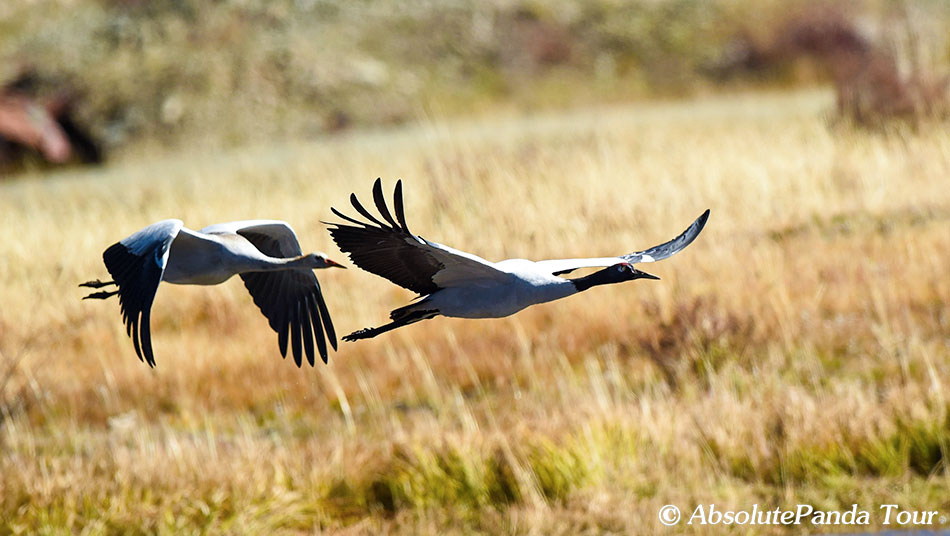
Black-necked Crane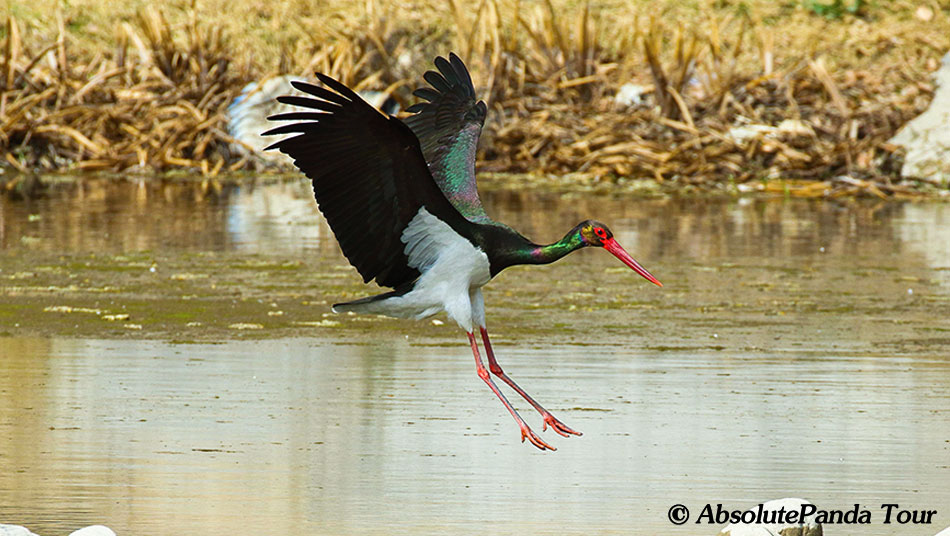
Black Stork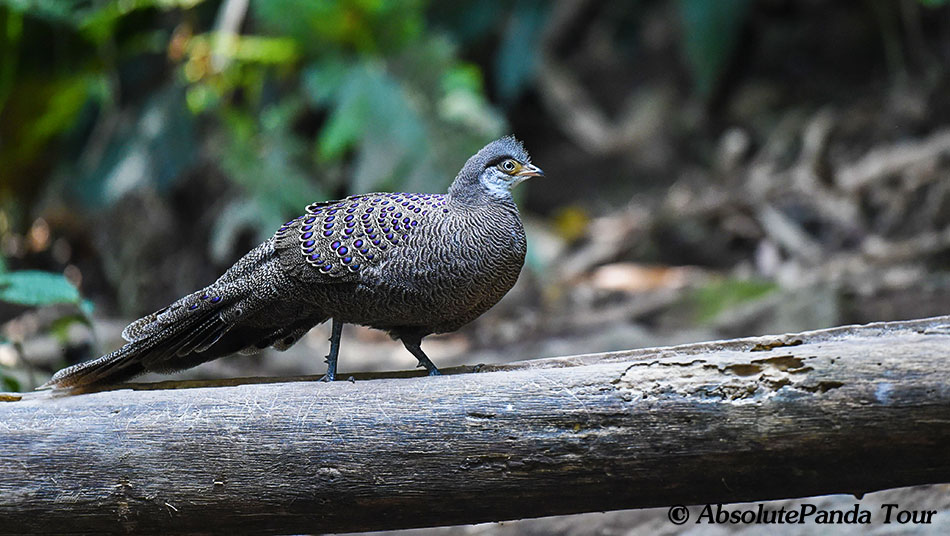
Grey Peacock Pheasant
Lady Amherst's Pheasant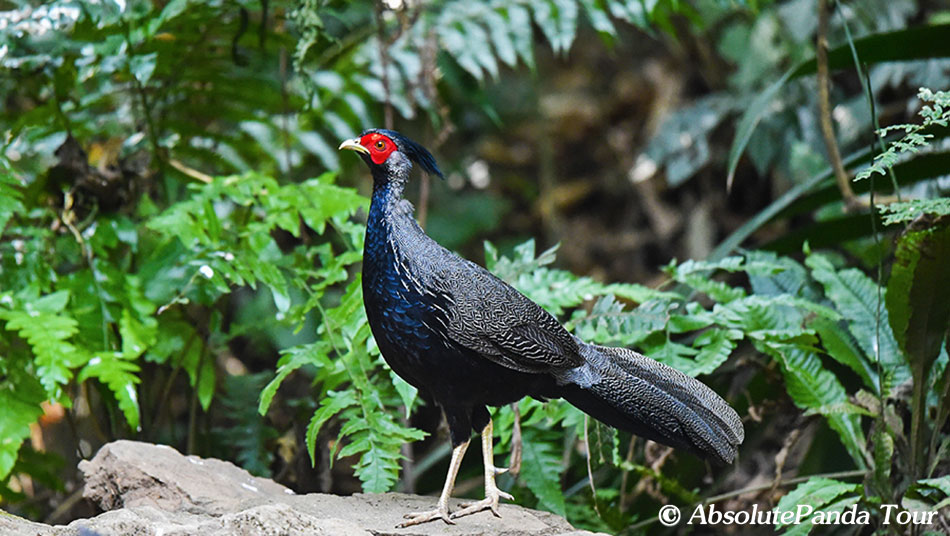
Kalij Pheasant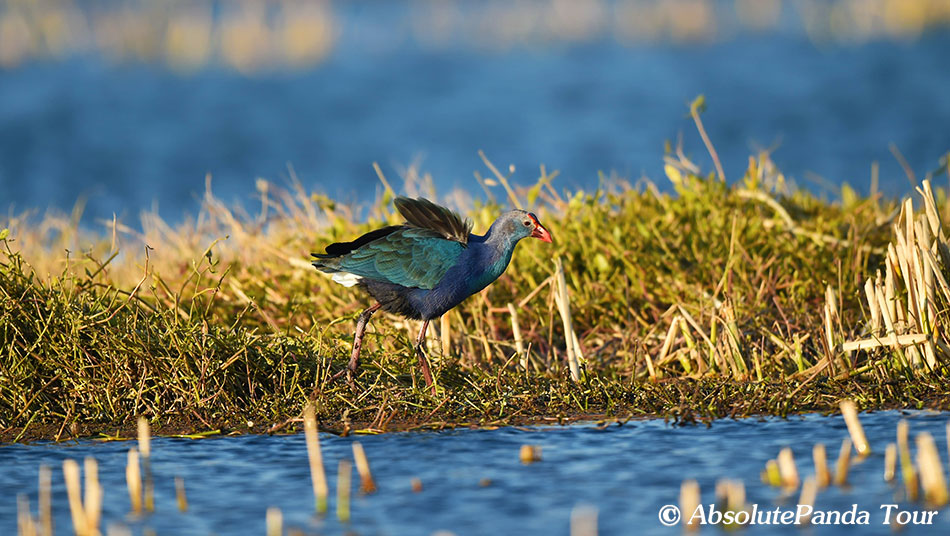
Grey-headed Swamphen
Rufous-throated Partridge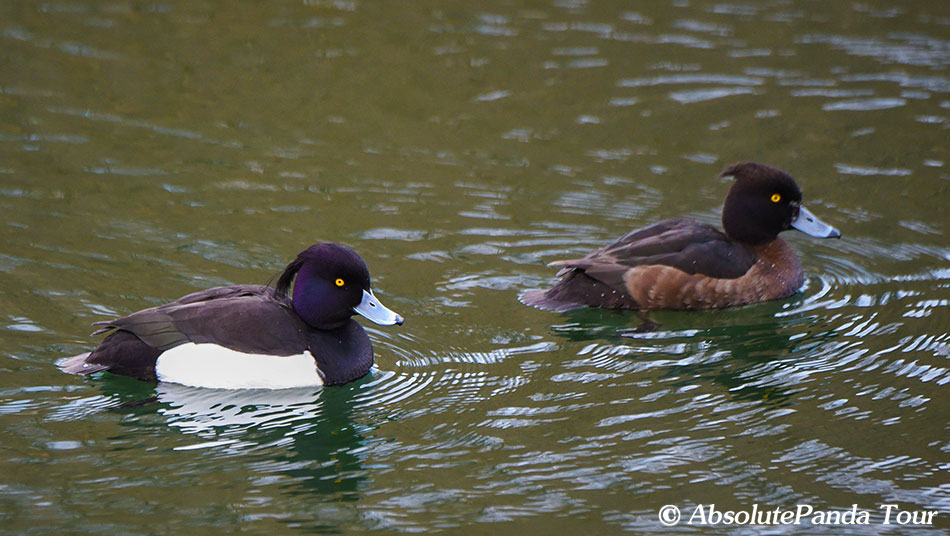
Tufted Duck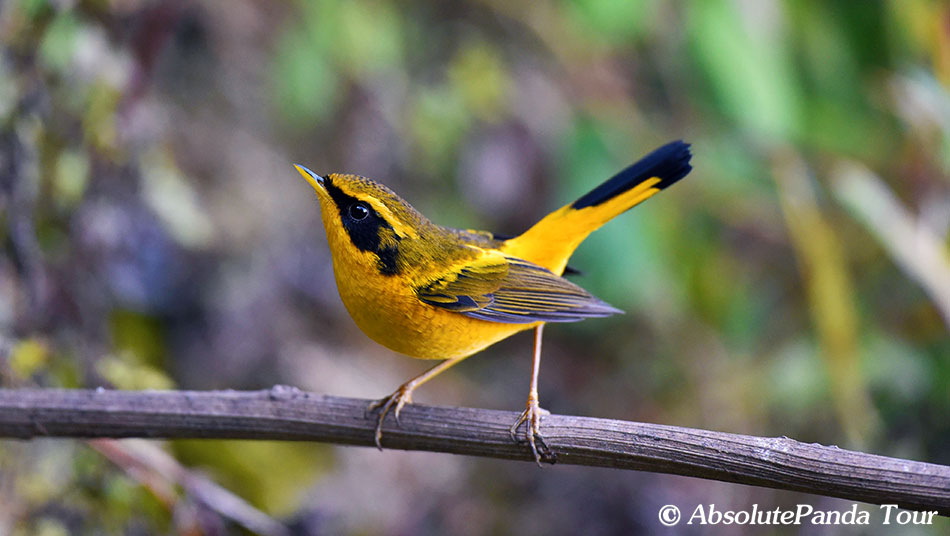
Golden Bush Robin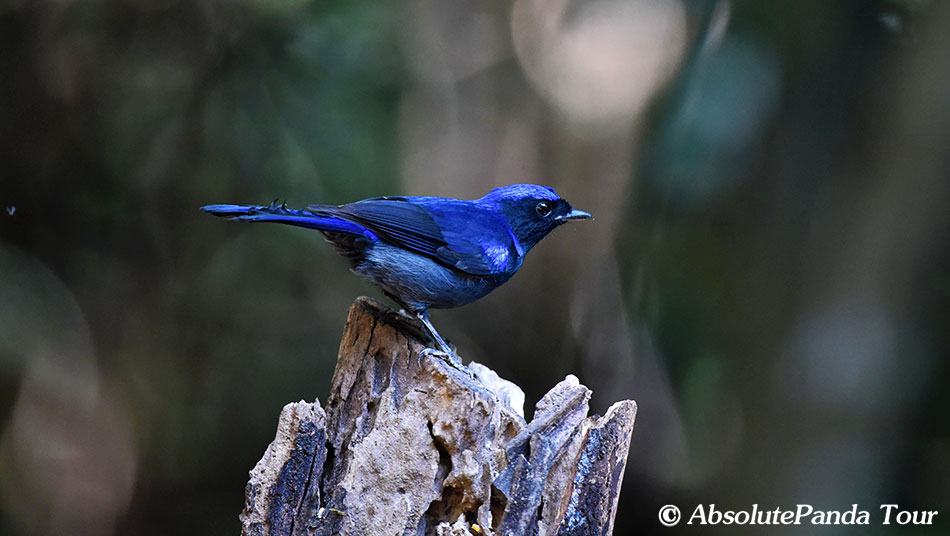
Large Niltava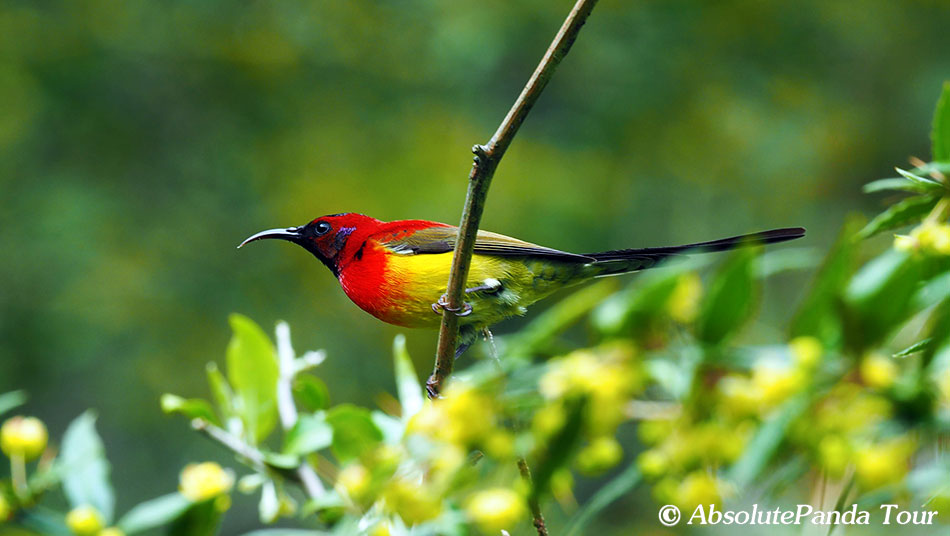
Mrs. Gould's Sunbird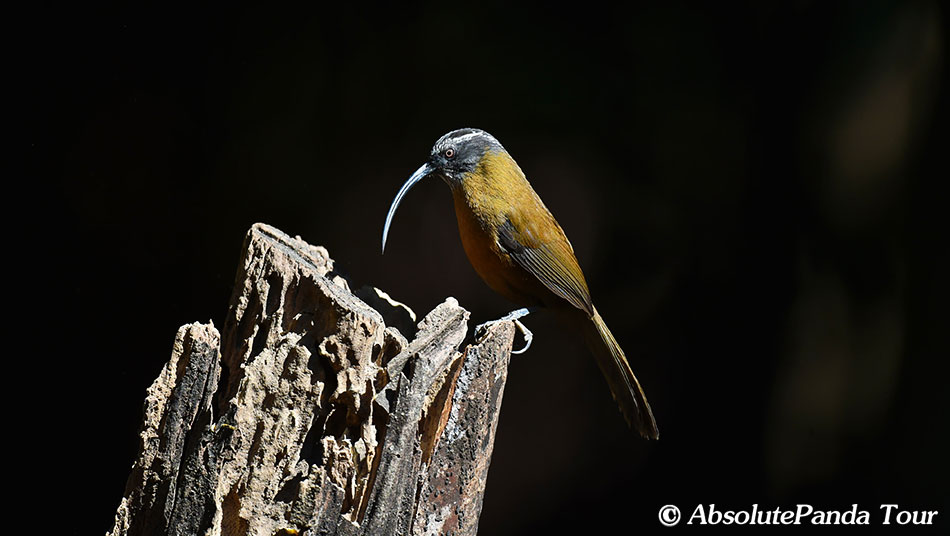
Slender-billed Scimitar Babbler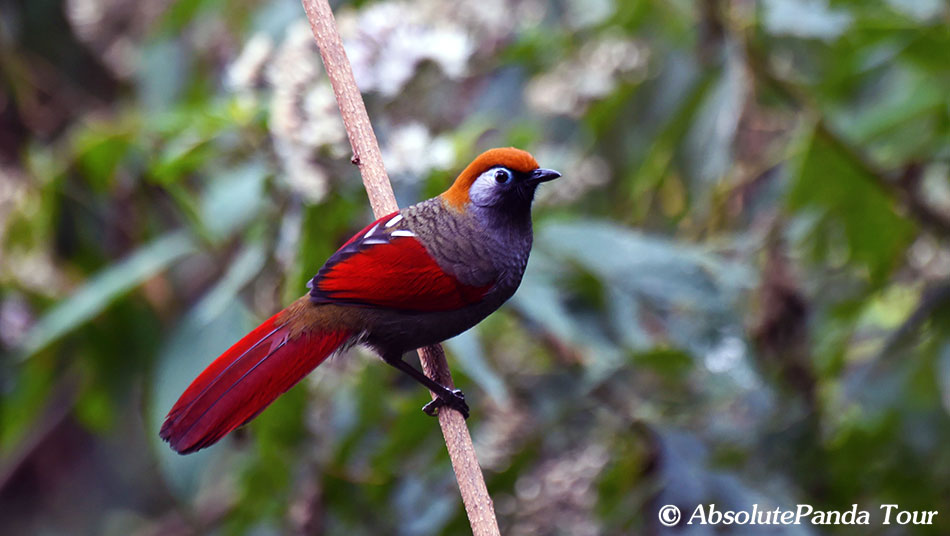
Red-tailed Laughingthrush
Welcome to email us and share your trip photo with us. Photo Album of AbsolutePanda
 info@absolutepanda.com
info@absolutepanda.com